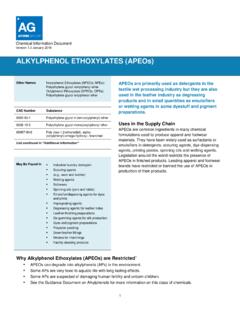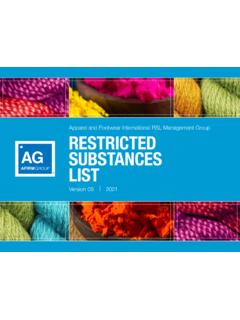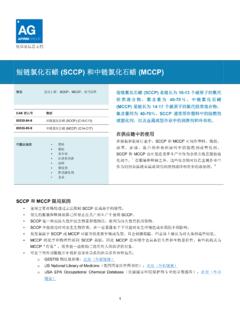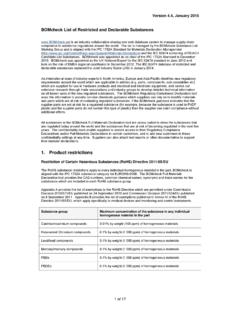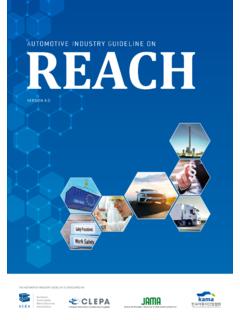Transcription of Apparel and Footwear International RSL Management Group ...
1 RESTRICTED SUBSTANCES LISTV ersion 04 | 2019 Apparel and Footwear International RSL Management Group New Classes of Chemical Substances Updates to Test Methods and Limits Scope of the AFIRM RSL Definition of Material Types New for 2019TM2 AFIRM Restricted substances list | 2019 Table of ContentsAFIRM Mission ..3 AFIRM Vision ..3 Legal Statement ..3 Policy Statement ..3 Scope of the AFIRM RSL ..4 Uses of the AFIRM RSL ..5 Links and Substances and Parameters to Consider ..6 AFIRM Chemical Information Sheets ..7 Definition of Ages ..7 Definition of Reporting Limits ..8 Definition of Material Types ..8 Change Log for the 2019 AFIRM RSL ..10 Materials in Which Restricted Substances Are Likely to Be Found ..11 AFIRM Restricted substances list ..14 Appendix A: Pesticides, Agricultural ..33 Apparel and Footwear International RSL Management (AFIRM) Group is the author of this work. You may reuse or adapt this work, with or without attribution to AFIRM more information about AFIRM, visit AFIRM Restricted substances list | 2019 AFIRM MissionAFIRM is the Apparel and Footwear International RSL Management (AFIRM) Working Group , established in 2004.
2 AFIRM s mission is to reduce the use and impact of harmful substances in the Apparel and Footwear supply chain. AFIRM s purpose is to provide a forum to advance the global Management of restricted substances in Apparel and Footwear , communicate information about chemical Management to the supply chain, discuss concerns, and exchange ideas for improving chemical VisionAFIRM continues to be a recognized global center of excellence, providing resources to enable continuous advancement of chemical Management best practices. We do this based on transparency, science, and collaboration with relevant industries and experts to build safer and more sustainable chemistry within the Apparel and Footwear supply chains. It is understood that in adopting this vision, AFIRM s mission, objectives, and projects will continue to be product-focused or Statement The AFIRM RSL constitutes information from AFIRM only and does not represent any individual AFIRM member.
3 Individual brand RSLs may differ in specific parameters. The AFIRM RSL is not intended to and does not establish any industry standard of care. The AFIRM RSL may not always provide the most appropriate approach for any individual company s chemical Management program. Many brands have implementation guidelines, and suppliers must follow those guidelines where required. The AFIRM RSL does not constitute legal advice and is not a substitute for legal advice. There is no warranty, express or implied, as to the completeness or utility of the information contained in this AFIRM RSL, including, without limitation, that the information is current and error-free. AFIRM disclaims liability of any kind whatsoever resulting from any use of or reliance on the AFIRM RSL. Policy StatementAFIRM has created the following Restricted substances list ( AFIRM RSL ) to assist and guide supply chain participants seeking to increase product quality and safety or reduce their environmental impact by limiting the use of certain substances in Apparel , Footwear , accessories and related products including sporting good AFIRM Restricted substances list | 2019 Scope of the AFIRM RSLThe AFIRM RSL covers Apparel , Footwear , accessories, and equipment.
4 Electrical and electronic components of products are excluded, as there are specific requirements for these items not covered under the current AFIRM RSL. Apparel . Any garment worn on the body intended to protect, cover, or adorn. Footwear . Any durable covering for the feet intended to protect, cover, or comfort. Accessories. Any product intended to complement Apparel , both carried and worn. Note: Jewelry is excluded, as it may be subject to additional safety and chemical requirements. Note: There may be additional requirements for some accessories, such as sunglasses. Equipment. Any product intended for use in sport or exercise, including protective equipment. Note: There may be safety and performance standards ( NOCSAE) for protective equipment, which are not covered in this document. Note: There may also be specific requirements for items that come into contact with food and the AFIRM member brands may differ on the types of products classified under each of these categories, suppliers are advised to check with their customers regarding brand-specific definitions, requirements, and product applicability.
5 AFIRM has provided examples of products to which the AFIRM RSL may be applied, including but not limited to those listed in Table Shirts Pants/trousers Shorts Skirts Dresses Swimwear Socks Jackets Vests Sweatshirts and hoodies Sweaters Underwear Sleepwear and loungewear Lifestyle Athletic ( running, training) Sports ( basketball, soccer, football, baseball) Sandals Flip flops Boots Slippers Hats Headbands Scarves Handbags Backpacks Sunglasses Shoelaces Belts Hair clips Gloves ( winter) Shin and leg guards Gloves ( baseball, football, golf) Chest protectors Balls ( basketball, football, soccer) Helmets Shoulder, knee, and elbow pads Yoga mats and blocks Rackets ( tennis, racquetball, badminton) Fitness equipment ( treadmills) BicyclesTable 1. Examples of Products within the Scope of the AFIRM RSL5 AFIRM Restricted substances list | 2019 Uses of the AFIRM RSLAFIRM member brands may differ on individual parameters; suppliers are advised to check with the customer regarding brand-specific requirements.
6 The AFIRM RSL leverages AFIRM s mission to reduce the use and impact of harmful substances in the Apparel and Footwear supply chain by providing a single set of information for maximum and in-depth implementation within the supply chain. Some examples of uses for the AFIRM RSL, depending on the objectives of the user, include: Providing a tool for vendors to establish chemical Management knowledge and processes. Building full or base compliance with AFIRM member chemical restrictions. Providing a common base for testing, which may be accepted by multiple AFIRM brands. AFIRM member companies determine and communicate to their vendors their testing requirements and acceptance of test and References Be proactive! These links provide additional important information regarding chemical Management and should be visited on a regular Packaging Restricted substances list Chemistry Toolkit English, Chinese, Vietnamese, and Spanish versionsAFIRM Chemical Information Sheets English, Chinese, Vietnamese, and Spanish versions Overview of legal chemical limits and country of origin fluorinated greenhouse gases; EC 842/2006 :L:2006:161:0001:0011:EN:PDFR egulated substances that deplete the ozone layer.
7 EC 1005/2009 :L:2009:286:0001:0030:EN:PDFZero Discharge of Hazardous Chemicals (ZDHC) Foundation Manufacturing Restricted substances list (MRSL) AFIRM Restricted substances list | 2019 Additional Substances and Parameters to ConsiderEU REACH Substances of very high concern Based on scientific evidence indicating potential hazards to human health or the environment, the European Commission (EC) and European Union (EU) member states propose substances of very high concern (SVHCs) for placement on the European Chemicals Agency (ECHA) Candidate List of Substances of very high concern for Authorisation. Placing a substance on the Candidate List triggers specific obligations for importers, producers, and suppliers of any article that contains one or more of these substances above percent by weight per component. The obligations include providing sufficient information to allow safe use of the article to brand and retail customers or, upon request, to a consumer within 45 days of receipt of the request.
8 In addition, ECHA must be notified if the substance (s) are present in article components above percent in quantities totaling over one ton per producer or importer per year. Notification is not required if the substance has already been registered for that use or when the producer or importer of an article can exclude exposure of humans and the environment during the use and disposal of the article. In such cases, the producer or importer must supply appropriate instructions to the recipient of the article. ECHA periodically updates the Candidate List; find the most current version at AFIRM member brands may differ on how they address SVHCs as well as the legal obligations. AFIRM advises suppliers to consult with their customers regarding brand-specific requirements for Proposition 65 Substances Each year, California publishes a list of chemicals known to the state to cause cancer or reproductive toxicity. Businesses that expose individuals to one or more of these chemicals must provide a clear and reasonable warning before the exposure occurs.
9 For consumer products, this is typically through warning labels on the products or retail signage. Note that this warning is not the same as a regulatory requirement indicating that the product is unsafe if a specific concentration is exceeded. Enforcement is carried out through civil lawsuits brought by the California attorney general, district attorneys, or private parties acting in the public interest. Additional information can be found at AFIRM member brands may differ on how they address warning-label requirements. AFIRM advises suppliers to consult with their customers regarding brand-specific requirements for Proposition 65 AFIRM Restricted substances list | 2019 AFIRM Chemical Information Sheets AFIRM member brands have produced a comprehensive set of educational materials advising suppliers about best practices for chemicals Management . Each chemical information sheet covers a chemical or class of chemicals, giving an overview of the substance (s), where they are likely to be found in the material manufacturing process, and how to maintain compliance with the AFIRM RSL.
10 The sheets contain some information relevant to packaging, and future revisions will include more specific complete library of chemical information sheets is available on the AFIRM website at ; additionally, links to individual information sheets are embedded in the pages that follow. The plus symbol next to a chemical or class of chemicals in the AFIRM RSL indicates that a information sheet is available; simply click on the chemical name, and your web browser will load a PDF of the information sheet for that substance . May 2017 Best Practices for Chemical Management 1 Acetophenone and 2-Phenyl-2-Propanol Other Names Uses in the Supply Chain There are few direct uses of acetophenone or 2-phenyl-2-propanol in the supply chain. These two chemicals are byproducts when a peroxide initiator called dicumyl peroxide (DCP) is used in ethyl-vinyl-acetate (EVA) foam production. DCP initiates a cross-linking reaction in EVA foam by creating peroxide radicals, and both acetophenone and 2-pheyl-2-propanol are potential endpoints for the radicals once they have been deactivated.

